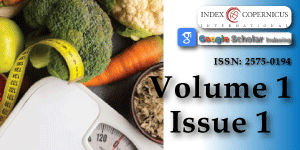Anti-nutrient and mineral properties of Complementry Food produced from Malted Red Sorgum and Defatted Soybean Flour Blend
Main Article Content
Abstract
This study was aimed at producing a high nutritious food that will meet the nutritional requirements of consumers. Blends of malted red sorghum and defatted soybeans flour were processed and the resulting flours were formulated at ratios of 100:00; 95:5; 90:10 and 80:20 (malted red sorghum: defatted soybeans flour). The resulting products were subjected to antinutrients and minerals properties determination. The results obtained showed that the antinutrients decreased linearly with increase in the mineral elements. Antinutrients in the blends decreased from 2.25-1.80mg/g (oxalate); 2.45-2.16mg/g (phytate); 14.16-9.26g/100g (Alkaloids); 2.12-1.69/100g (saponin) and 0.18-0.13mg/g (Tannin). A percentage increase of 12.6% (sodium); 10.8% (calcium); 9.5% (potassium); 3.7% (magnesium) and 14.1% (Iron) was recorded as the quantity of defatted soybeans flour increased in the blends. The low levels of antinutrients in the blends produced make them safe and suitable for human consumption. Substitution of malted red sorghum with 20% defatted soybean flour showed a remarkable improvement in the mineral contents of the diets.
Article Details
Copyright (c) 2017 Oloye DA, et al.

This work is licensed under a Creative Commons Attribution 4.0 International License.
Murray CJ, Lopez AD. Global Mortality, disability and the contribution of risk factors: Global burden of disease study. Lancet. 1997; 349: 1436-1442. Ref.: https://goo.gl/8goaZa
Granthan-Mcgregor S, Cheung YB, Cueto S, Glewwe P, Richter L, et al. Developmental potential in the first 5years for children in developing countries. Lancet. 2007; 369: 60-70. Ref.: https://goo.gl/CsNFJa
Onweluzo JO, Nwabugwu CC. Development and evaluation of weaning foods from pigeon pea and millet. Pakistan J Nutri. 2009; 8: 725-730. Ref.: https://goo.gl/TW1Sri
Caulfield LE, Zava aleta N, Figueoroa A. Adding Zinc to prenatal iron and Folate supplement improves maternal and neonatai zinc status in a Peruvian Population. Am J Clin Nutr. 1999; 69: 1257-1263. Ref.: https://goo.gl/5awiQd
Food and Agriculture Organization. Sorghum and Millets in Human Nutrition: Chapter 5. Nutritional quality of foods prepared from Sorghum and Millets. FAO Corporate Document Repository. 2009. Ref.: https://goo.gl/wccdXH
Giampietro PG, Bruno G, Furcolo G, Casali A, Brunetti E, et al. Soy Protein Formulas in Children: No Hormonal Effects in Long-Term Feeding. J Pediatr Endocrinol Metab. 2004; 17: 191-196. Ref.: https://goo.gl/MsNJPK
Anderson JW, Johnstone BM, Cook-Newell ME. Meta-Analysis of the Effects of Soy Protein Intake on Serum Lipids. New England J Med. 1995; 333: 276-282. Ref.: https://goo.gl/PRdWsB
Ene-Obong HN, Carnovale E. A comparison of the proximate, minerals and amino acid composition of some known and lesser known legumes in Nigeria. Food Chem. 1992; 43: 169-175. Ref.: https://goo.gl/yxd1eR
Strom BL, Schinnar R, Ziegler EE, Barnhart KT, Samuel MD, et al. Soybeans, Production/crops/World for 2014. FAOSTAT. 2015. Ref.: https://goo.gl/BRceTr
Hellen E, Ibenglu S, Ainsworth P. Effect of fermented and germinated cowpea flour addition on the rheological and bakery properties of wheat flour. J Food Engr. 2003; 63: 177-184. Ref.: https://goo.gl/v1VYv4
Iwe MO. The Science and Technology of Soybean: Chemistry, Nutrition, Processing and utilization 1 Edition. Rejoin commun serv Enugu. 115-146.
Official method of analysis, 17 (ED). Association of Official Analytical Chemist. AOAC. 2000; 2:112-120. Ref.: https://goo.gl/AfNgHd
Lauren AC, Mendoza EMT. Effects of soaking in aqueous, acidic and alkaline solution on removal of polyphenols and in-vitro digestibility of cowpea. Plant Food Human Nutr. 1986; 36: 107-118. Ref.: https://goo.gl/k7WtYn
Onwuka GI. Physicochemical, Nutritional and Functional Properties of the Epicarp, Flesh and Pitted Sample of Doum Fruit (Hyphaene Thebaica). J food Nutr res. 2005; 2: 129-149. Ref.: https://goo.gl/dUwYVg
Ene-Obong HN, Obizora IC. Effect of dosmestic processing on the cooking time, nutrients, antinutients and in-vitro protein digestibility of the Africa yam bean (Sphenostylis stenocarpa). Plant food Human Nutr. 1996; 49: 43-52. Ref.: https://goo.gl/sqodHN
Osagie AU. Antinutrient factors. In: Nutritional Quality of Plant Foods. 1998; 37-49. Ref.: https://goo.gl/LQeM7k
Akinyeye RO, Oluwadunsi O, Omoyeni A. Proximate, minerals, antinutient and phytochemical screening and amino acid composition of the leaves of Pterocarpus mildraedi harms. Electr J Environ, Agricul Food Chem. 2011; 10: 1848-1857. Ref.: https://goo.gl/BpAoer
Miniello VL, Moro GE, Tarantino M, Natile M, Granieri L. Soybean based Formulas and Phyto-oestrogens: A Safety Profile. Acta Paediatrica. 2003; 92: 93-100. Ref.: https://goo.gl/NYpR4k
Ferro C, Deelstra H, Ulietink A. Condensed vegetable tannins. Biochemical Systematic and Ecology. 2005; 454-459.

